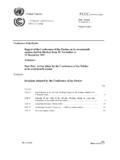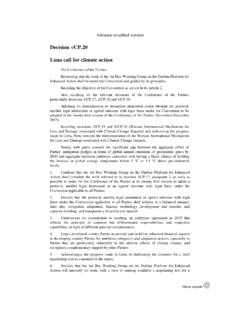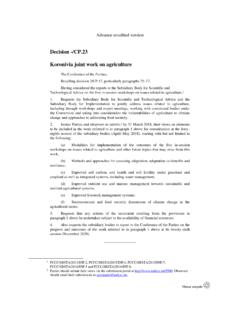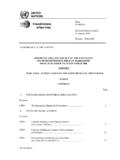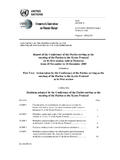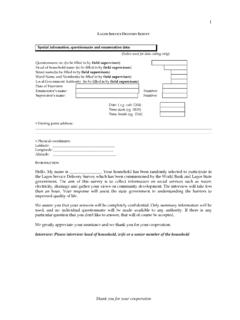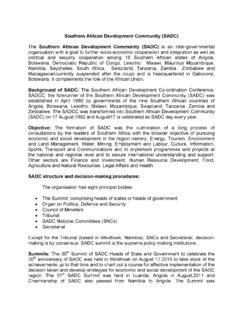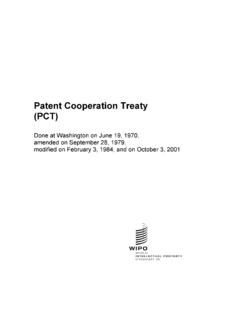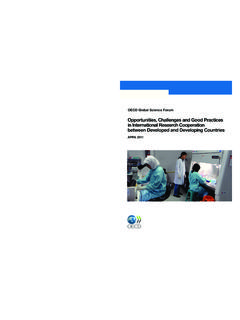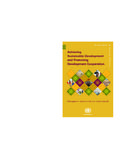Transcription of Technology Executive Committee - UNFCCC
1 United Nations Framework Convention on Climate Change TEC Brief #9. Technology Executive Committee South South cooperation and triangular cooperation on technologies for adaptation in the water and agriculture sectors United Nations Technology Executive Committee Framework Convention on South South cooperation and triangular cooperation on technologies for Climate Change adaptation in the water and agriculture sectors Why this TEC Brief? Water and agriculture are essential for poverty reduction, be more accessible, adaptable and affordable than those sustainable development and human well-being. from developed An essential alternative for Agriculture accounts for 70 per cent of total global freshwater developing countries in responding to the growing pressure withdrawals, making it the largest user of water along the of climate change on resource systems is therefore to step entire agrifood supply The links between water and up cooperation for the exchange of more cost-effective agriculture will be exacerbated in the near future under the technologies for adaptation, including in the context for pressure of population growth and climate change.
2 Estimates implementating their national adaptation plans (NAPs), indicate that 60 per cent more food will need to be produced nationally determined contributions (NDCs) and the to feed the world's population by 2050 and total global water Sustainable Development Goals (SDGs).5. withdrawals for irrigation are projected to increase by 10 per cent in the same Further the outcomes of the 2013 Yet, the potential for South South cooperation and triangular third synthesis report on the Technology needs assessments cooperation (SSC/TrC) on technologies for adaptation in the of Parties not included in Annex I to the Convention: For water and agriculture sectors remains largely adaptation, the most commonly prioritized sectors were Based on a mapping of SSC/TrC initiatives, an e-survey of agriculture (84 per cent of the Parties) and water resources national designated entities (NDEs)7 and consortium partners (77 per cent).
3 3 and members of the Climate Technology Centre and Network (CTCN),8 and recommendations of the Technology Executive Adapting water management and agricultural practices to Committee (TEC),9 this TEC Brief outlines the challenges for climate variability requires integrated responses that address SSC/TrC on technologies for adaptation, reviews best practices the complex and interrelated nature of global resource and lessons learned, and highlights the roles of different systems. These integrated responses can be fostered through stakeholders in the successful replication and transfer of the exchange of technologies that countries accumulate technologies for adaptation in the context of SSC/TrC. in their own development processes and which tend to UNDP. 2. United Nations Technology Executive Committee Framework Convention on South South cooperation and triangular cooperation on technologies for Climate Change adaptation in the water and agriculture sectors Highlights CTCN.
4 The adoption of the 2030 Agenda for Sustainable De- velopment and the entry into force of the Paris Agree- ment may bring opportunities for countries to increase SSC/TrC for enhancing the transfer and deployment of adaptation technologies. SSC/TrC can further assist countries in implementing their priority adaptation actions as articulated in their NDCs, NAPs and other national and subnational ad- aptation planning efforts. Countries may count on the efforts taken by govern- ments, research institutes and global institutions and mechanisms like the TEC and the CTCN to catalyse SSC/. TrC on technologies for adaptation. Local stakeholders should also be involved and empo- wered to enable the replication and improvement of local solutions and thus promote the sustainable ap- plication of technologies for adaptation. The integration of hardware, software and orgware is also necessary and should be supported by flexible programmes and partnerships.
5 Effective coordination and integration of technologies for adaptation in cross-sectoral planning and policy formulation by local and national governments should be pursued to ensure the implementation of appropri- ate adaptation actions. Similarly, institutional support to SSC/TrC for knowled- ge management and information-sharing and linka- ges between climate change and other development areas should be explored and properly reflected in ad- aptation action within NAPs and NDCs. Other global mechanisms, international networks and organizations such as the United Nations Office for South South cooperation (UNOSSC) can further sup- port and promote SSC/TrC on technologies for adapta- tion and strengthen links with the SDGs. UNEP. 3. United Nations Technology Executive Committee Framework Convention on South South cooperation and triangular cooperation on technologies for Climate Change adaptation in the water and agriculture sectors The potential of South South and triangular cooperation on technologies for adaptation Adaptation experience is accumulating across regions in Mapping of South South cooperation the public and private sectors and within communities.
6 Figure 1: on technologies for adaptation in the water Governments at various levels are starting to develop and agriculture sectors adaptation plans and policies to integrate climate change considerations into broader development SSC/. TrC can help increase the adaptive capacity of countries by transferring knowledge and Technology that tend to be Mapping of SSC initiatives in technologies attuned to local geoclimatic conditions, scaled down to levels for adaptation in water and agriculture appropriate to the size of local markets, and adaptable to Types of SSC engagements the reality of low-income consumers. This knowledge and Technology can further build local capacity and enhance countries' ability to adapt to climate change. Percentage 29%. Yet, the potential of SSC/TrC on technologies for adaptation remains largely untapped. An e-survey conducted on 46%.
7 138 NDEs to the CTCN, 14 CTCN consortium partner representatives and 102 CTCN members revealed that nearly 25%. 50 per cent of the organizations had never engaged in SSC 0 10 20 30 40 50. on technologies for adaptation in the agriculture and water sectors. The relatively few existing SSC/TrC initiatives on technologies for adaptation in the agriculture and water SSC projects sectors tend to be concentrated in a small number of countries (see figure 1).11 There are also few SSC initiatives that focus on the intersection between water, agriculture and climate change (see figure 1).12 The SSC/TrC technologies for adaptation in the agriculture and water sectors in the largest potential demand by developing countries are illustrated in figures 2 and 12 9 7. Agriculture Water Agriculture- Two main factors seem to contribute to these phenomena. water- climate First, the lack of a universally accepted definition of SSC/ change TrC poses questions on whether SSC/TrC encompasses people-to-people in addition to government-to-government cooperation .
8 Second, the financial crisis that has affected Overall regional participation (provider and recipient). northern countries and its impact on traditional aid, combined with the emergence of Brazil, Russian Federation, India, China and South Africa, has contributed to confining Latin America and the Caribbean SSC/TrC to an instrument of foreign policy of emerging powers', when in fact it includes a much wider array of Asia narratives, actors and modalities. Adding to this is the fact that South South partners do not report to the Organisation Arab States for Economic Co-operation and Development Development Assistance Committee and that data and information on SSC/. Africa TrC remain limited. As such, many SSC/TrC initiatives fall off the radar and opportunities for SSC/TrC are missed. This is particularly true for Eastern Europe and the Arab States, Pacific which have been the first to adapt agriculture and water systems to climate change and have become a laboratory' for new technologies for adaptation.
9 4. United Nations Technology Executive Committee Framework Convention on South South cooperation and triangular cooperation on technologies for Climate Change adaptation in the water and agriculture sectors Largest potential demand for South South Largest potential demand for South South Figure 2: and triangular cooperation on adaptation Figure 3: and triangular cooperation on adaptation technologies in the agriculture sector technologies in the water sector SSC/TrC technologies for adaptation in the agriculture sector SSC/TrC technologies for adaptation in the water sector with the with the largest potential demand/most demanded largest potential demand/most demanded by developing countries by developing countries Water-pricing specifications Structures such as Other farming Resilient crop 9% ponds, wells, systems varieties reservoirs Water-user 16% 22% 21%.
10 Associations 9%. Farmer-led sustainable Water agriculture recycling 16% techniques Seasonal 21%. forecasts Rainwater 22% harvesting Water-saving Desalination equipment irrigation 21% 28%. 24%. Main challenges to South South and triangular cooperation on technologies for adaptation in the agriculture and water sectors In order to meet the potential demand for technologies for in SSC/TrC. The measures put forward to overcome this adaptation and to enhance support for SSC/TrC initiatives, challenge were quite diverse and include: establishing quality SSC/TrC partners must address challenges such as: limited control systems and agricultural crediting and certification knowledge of southern adaptation technologies and systems; formulating detailed regulations and standards initiatives; lack of or inadequate access to financial resources; for prioritized Technology ; creating policies to enforce land inadequate legal and regulatory frameworks; and insufficient utilization and avoid conflicts between farmers.



